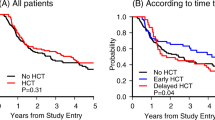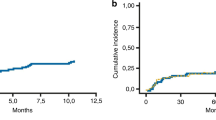Abstract
In this retrospective study, 63 patients >60 years with hematological malignancies and treated with allo-SCT and with reduced-intensity conditioning (RIC) were reviewed. A total of 51% of patients suffered from AML or myelodysplastic syndromes. Disease status before transplantation was CR or PR 71 with 29% transplanted with active disease. Patients were classified according to three published prognostic indexes: (1) hematopoietic cell transplantation comorbidity index (HCT-CI); (2) European BMT (EBMT) score; and (3) Pretransplantation Assessment of Mortality (PAM) score. The 100-day and 1-year treatment-related mortality (TRM) were 6 and 22%, respectively, for the entire group. The 2-year OS and PFS were 60 and 58%, respectively. The incidence of grade II–IV acute GVHD (aGVHD) and extensive chronic GVHD was 46 and 48%, respectively. In a univariate analysis, neither the HCT-CI nor the EBMT score, nor the PAM score were predictive of TRM and OS. Only the occurrence of aGVHD affected the TRM and OS. ALLO-RIC is feasible in elderly patients. Even if those prognostic scores were not adapted to elderly patients, they did not predict for TRM and OS. aGVHD is the main cause of TRM and more efforts should be made to reduce its incidence without sacrificing graft vs tumor effect.
This is a preview of subscription content, access via your institution
Access options
Subscribe to this journal
Receive 12 print issues and online access
$259.00 per year
only $21.58 per issue
Buy this article
- Purchase on Springer Link
- Instant access to full article PDF
Prices may be subject to local taxes which are calculated during checkout



Similar content being viewed by others
References
Blaise D, Vey N, Faucher C, Mohty M . Current status of reduced-intensity-conditioning allogeneic stem cell transplantation for acute myeloid leukemia. Haematologica 2007; 92: 533–541.
McClune BL, Weisdorf DJ, Pedersen TL, Tunes da Silva G, Tallman MS, Sierra J et al. Effect of age on outcome of reduced-intensity hematopoietic cell transplantation for older patients with acute myeloid leukemia in first complete remission or with myelodysplastic syndrome. J Clin Oncol 2010; 28: 1878–1887.
Gupta V, Daly A, Lipton JH, Hasegawa W, Chun K, Kamel-Reid S et al. Nonmyeloablative stem cell transplantation for myelodysplastic syndrome or acute myeloid leukemia in patients 60 years or older. Biol Blood Marrow Transplant 2005; 11: 764–772.
Falda M, Busca A, Baldi I, Mordini N, Bruno B, Allione B et al. Gruppo Italiano Trapianto Midollo Osseo (GITMO). Nonmyeloablative allogeneic stem cell transplantation in elderly patients with hematological malignancies: results from the GITMO (Gruppo Italiano Trapianto Midollo Osseo) multicenter prospective clinical trial. Am J Hematol 2007; 82: 863–866.
Bertz H, Potthoff K, Finke J . Allogeneic stem-cell transplantation from related and unrelated donors in older patients with myeloid leukemia. J Clin Oncol 2003; 21: 1480–1484.
Spyridonidis A, Bertz H, Ihorst G, Grüllich C, Finke J . Hematopoietic cell transplantation from unrelated donors as an effective therapy for older patients (> or = 60 years) with active myeloid malignancies. Blood 2005; 105: 4147–4148.
Shapira MY, Resnick IB, Bitan M, Ackerstein A, Samuel S, Elad S et al. Low transplant-related mortality with allogeneic stem cell transplantation in elderly patients. Bone Marrow Transplant 2004; 34: 155–159.
Charlson ME, Pompei P, Ales KL, MacKenzie CR . A new method of classifying prognostic comorbidity in longitudinal studies: development and validation. J Chronic Dis 1987; 40: 373–383.
Sorror ML, Maris MB, Storb R, Baron F, Sandmaier BM, Maloney DG et al. Hematopoietic cell transplantation (HCT)-specific comorbidity index: a new tool for risk assessment before allogeneic HCT. Blood 2005; 106: 2912–2919.
Sorror M, Storer B, Sandmaier BM, Maloney DG, Chauncey TR, Langston A et al. Hematopoietic cell transplantation-comorbidity index and Karnofsky performance status are independent predictors of morbidity and mortality after allogeneic nonmyeloablative hematopoietic cell transplantation. Cancer 2008; 112: 1992–2001.
Farina L, Bruno B, Patriarca F, Spina F, Sorasio R, Morelli M et al. The hematopoietic cell transplantation comorbidity index (HCT-CI) predicts clinical outcomes in lymphoma and myeloma patients after reduced-intensity or non-myeloablative allogeneic stem cell transplantation. Leukemia 2009; 23: 1131–1138.
Pollack SM, Steinberg SM, Odom J, Dean RM, Fowler DH, Bishop MR . Assessment of the hematopoietic cell transplantation comorbidity index in non-Hodgkin lymphoma patients receiving reduced-intensity allogeneic hematopoietic stem cell transplantation. Biol Blood Marrow Transplant 2009; 2: 223–230.
Parimon T, Au DH, Martin PJ, Chien JW . A risk score for mortality after allogeneic hematopoietic cell transplantation. Ann Intern Med 2006; 144: 407–414.
Gratwohl A, Stern M, Brand R . Risk score for outcome after allogeneic hematopoietic stem cell transplantation: a retrospective analysis. Cancer 2009; 115: 4715–4726.
Mohty M, Bay JO, Faucher C, Choufi B, Bilger K, Tournilhac O et al. Graft-versus-host disease following allogeneic transplantation from HLA-identical sibling with antithymocyte globulin-based reduced-intensity preparative regimen. Blood 2003; 102: 470–476.
Kaplan EL, Meier P . Nonparametric estimation from incomplete observations. J Am Stat Assoc 1958; 53: 457–481.
Estey E, de Lima M, Tibes R, Pierce S, Kantarjian H, Champlin R et al. Prospective feasibility analysis of reduced-intensity conditioning (RIC) regimens for hematopoietic stem cell transplantation (HSCT) in elderly patients with acute myeloid leukemia (AML) and high-risk myelodysplastic syndrome (MDS). Blood 2007; 109: 1395–1400.
Xhaard A, Porcher R, Chien JW, de Latour RP, Robin M, Ribaud P et al. Impact of comorbidity indexes on non-relapse mortality. Leukemia 2008; 22: 2062–2069.
Guilfoyle R, Demers A, Bredeson C, Richardson E, Rubinger M, Szwajcer D et al. Performance status, but not the hematopoietic cell transplantation comorbidity index (HCT-CI), predicts mortality at a Canadian transplant center. Bone Marrow Transplant 2009; 43: 133–139.
Acknowledgements
We thank the nursing staff for providing excellent care for our patients, and the physicians of the Hematology Department at the Institut Paoli-Calmettes for their important study contributions and dedicated patient care. We thank BF Petersen for revising the paper. Part of this work benefited from a special grant from the ‘Association pour la Recherche Contre le Cancer (ARC)’ (program ARECA).
Author information
Authors and Affiliations
Corresponding author
Ethics declarations
Competing interests
The authors declare no conflict of interest.
Rights and permissions
About this article
Cite this article
Castagna, L., Fürst, S., Marchetti, N. et al. Retrospective analysis of common scoring systems and outcome in patients older than 60 years treated with reduced-intensity conditioning regimen and alloSCT. Bone Marrow Transplant 46, 1000–1005 (2011). https://doi.org/10.1038/bmt.2010.227
Received:
Revised:
Accepted:
Published:
Issue Date:
DOI: https://doi.org/10.1038/bmt.2010.227
Keywords
This article is cited by
-
A high hematopoietic cell transplantation comorbidity Index (HCT-CI) does not impair outcomes after non-myeloablative allogeneic stem cell transplantation in acute myeloid leukemia patients 60 years or older
Bone Marrow Transplantation (2023)
-
Increased opportunity for prolonged survival after allogeneic hematopoietic stem cell transplantation in patients aged 60–69 years with myelodysplastic syndrome
Annals of Hematology (2019)
-
Up-to-date tools for risk assessment before allogeneic hematopoietic cell transplantation
Bone Marrow Transplantation (2016)
-
Prediction of non-relapse mortality in recipients of reduced intensity conditioning allogeneic stem cell transplantation with AML in first complete remission
Leukemia (2015)
-
Graft failure in the modern era of allogeneic hematopoietic SCT
Bone Marrow Transplantation (2013)



